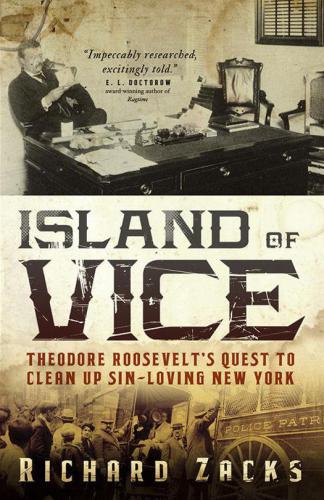
Island of Vice
Theodore Roosevelt's Quest to Clean Up Sin-Loving New York
کتاب های مرتبط
- اطلاعات
- نقد و بررسی
- دیدگاه کاربران
نقد و بررسی

December 5, 2011
Zacks (The Pirate Hunter) looks back to the 1890s, when two million New Yorkers faced crime in the concrete canyons. In addition to the Rev. Charles Parkhurst, who declared “a holy war on vice,” the cast includes such notables as Tammany police captain “Big Bill” Devery, crime reporter Jacob Riis, cartoonist Walt McDougall, Mayor William Strong, journalist Lincoln Steffens, and the city itself. As Zacks writes: “New York was a thousand cities masquerading as one. Its noise, vitality, desperation, opulence, hunger, all struck visitors.” With bars, casinos, and 30,000 prostitutes, New York was the country’s vice capital, and police corruption was rampant. Enter crusading and nattily attired police commissioner Theodore Roosevelt, who admitted he “knew nothing of police management.” An uncompromising reformer, Roosevelt tackled the Tammany Hall political machine, though he confronted resistance in his efforts to close the brothels, gambling joints, and after-hours saloons. Zacks probes this period of Roosevelt’s life with exhaustive details, drama, and intrigue. The 40 pages of bibliographic notes indicate the five years of research that went into this remarkable re-creation of fin-de-siècle New York. Writing with a prismatic, poetic slant, Zacks unveils a colorful portrait of a volcanic Roosevelt towering over the soul of the city. Agent: Esther Newberg, ICM.

December 15, 2011
Zacks (The Pirate Coast: Thomas Jefferson, the First Marines, and the Secret Mission of 1805, 2005, etc.) returns with a sharply focused look at Theodore Roosevelt's brief tenure as a New York City police commissioner. The author begins and ends with allusions to the naked goddess Diana perched atop Madison Square Garden--his symbol for the sensual interests of New Yorkers that Roosevelt was intent on controlling, if not diminishing to the vanishing point. Zacks sketches the anti-vice career of crusading preacher Charles H. Parkhurst, whose efforts Roosevelt supported and broadened. The incredibly energetic Roosevelt worked long daylight hours and then, often, patrolled the streets at night, checking up on cops to see who was sleeping, drinking, whoring and otherwise neglecting his duty. Frequently accompanying and guiding Roosevelt was journalist Jacob Riis, whose pioneering photo-journalistic How the Other Half Lives highlighted the economic extremities endured by many in the city. As Zacks points out, Roosevelt had initial popular and journalistic support for his efforts at vice control, but when he began devoting many police resources (and lots of political capital) to enforcing blue laws, both the press and the public began to turn against him. Because many workers had only Sundays off, the dry-on-Sunday policy made many working men and women very unhappy. As the political sands shifted beneath him, Roosevelt redoubled his efforts, alienating more voters, and began seeking ways out of his increasingly stressful and polarizing position. Relief came when newly elected President McKinley appointed him the assistant secretary of the Navy. The author takes us inside fin-de-siècle brothels and bars, Tammany Hall and courtrooms, contentious commissioners' meetings and cops' barracks. A nuanced, comprehensive portrait of unique man and the surrounding period, culture and political system.
(COPYRIGHT (2011) KIRKUS REVIEWS/NIELSEN BUSINESS MEDIA, INC. ALL RIGHTS RESERVED.)

January 1, 2012
Theodore Roosevelt enjoyed an almost storied political rise, with one of the more intriguing chapters being his time as one of four New York City police commissioners. He was appointed in 1895 with a mandate to clean up the city, "the vice capital of the United States." Zacks (The Pirate Hunter: The True Story of Captain Kidd) shows the widespread municipal corruption that affected the entire police force, enabling prostitution, gambling, and lax enforcement of Sunday no-drinking laws. He has mined archival riches that offer remarkably graphic eye-witness accounts of undercover visits made by Roosevelt and other reformers to saloons, brothels, and other such establishments. TR was largely successful in reforming the police and reducing vice crimes. While Zacks feels these were largely Pyrrhic victories, he suggests that the real legacy of these efforts was that Roosevelt became a stronger politician and a more effective orator. This valuable addition to the TR canon sheds further light on the future President as alternatively arrogant and obstinate, if not downright absolutist, in the execution of his office, qualities that would continue to dog him in later years. VERDICT Highly recommended to a wide range of readers, especially those interested in presidential history or late 19th-century America's social issues.--Richard S. Drezen, Brooklyn, NY
Copyright 2012 Library Journal, LLC Used with permission.

February 1, 2012
Set in gas-lit 1890s Manhattan, Zacks' depiction of virtue versus vice pits Theodore Roosevelt against a gallery of antagonists. Some are thugs on the street, harlots in the doorway, and dram sellers on the stoop. Others are crooked police and TR's fellow commissioners on the police board, of which he was a member from 1895 to 1897. The period is integral to Roosevelt's legend as a pugnacious scourge of corruption, though Zacks' episode-by-episode narrative of his hyperactive tenure indicates that Satan's Circus (2007), as Mike Dash aptly titled his book about this era of New York City history, was only mildly interrupted by Roosevelt's exertions. Nevertheless, his fight is a fascinating story that Zacks relays with zest. His pungent vignettes of sinful establishments and the police who protected them hang on the main plot of TR's campaigns to dismiss bad cops and enforce long-dormant alcohol and prostitution laws, which often resulted in proceedings showcasing TR at his most combatively indignant. His research artfully attired in active prose, Zacks writes a winner for TR and NYC buffs.(Reprinted with permission of Booklist, copyright 2012, American Library Association.)

























دیدگاه کاربران